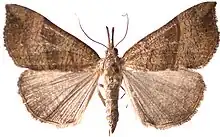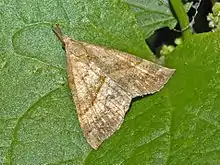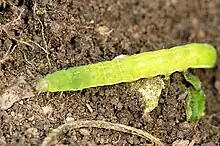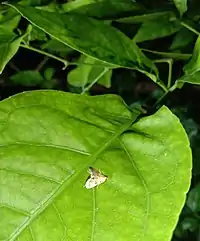Hypena proboscidalis
Hypena proboscidalis, the snout, is a moth of the family Erebidae. The species was first described by Carl Linnaeus in his 1758 10th edition of Systema Naturae.
| Hypena proboscidalis | |
|---|---|
 | |
| H. proboscidalis from Eure-et-Loir, France | |
 | |
| Scientific classification | |
| Domain: | Eukaryota |
| Kingdom: | Animalia |
| Phylum: | Arthropoda |
| Class: | Insecta |
| Order: | Lepidoptera |
| Superfamily: | Noctuoidea |
| Family: | Erebidae |
| Genus: | Hypena |
| Species: | H. proboscidalis |
| Binomial name | |
| Hypena proboscidalis | |
Distribution and habitat
This species is found in Europe in the north to the Arctic Circle.[1] To the east it ranges across the Palearctic including North Africa, Siberia, Iran, the Altai Mountains, Kamchatka, Kashmir, India, China, Korea, Japan and Taiwan.[2] In the Alps and India, it rises to elevations of over 1600 metres.
Technical description and variation
%252C_Elst_(Gld)%252C_the_Netherlands.jpg.webp)
The wingspan is 25–38 mm.[3] Its forewings are grey brown with numerous dark transverse striae, and with a brownish-yellow suffusion in the females; the lines dark brown; the inner curved or bent in middle; the outer oblique, nearly straight, slightly incurved at costa, internally shaded with dark brown; the subterminal cloudy and partially interrupted, above middle marked with black white-tipped dashes, followed by a brown cloud, the subapical edge of which is oblique; hindwing pale greyish.

As a rule most females are brownish, — ab. brunnea Tutt, —- most males grey without the brown; - the form deleta Stgr., from the Altai Mts., Amurland, and Kamschatka, is paler, the forewing yellowish, sprinkled with brown, with less distinct markings; - tatorhina Btlr. [full species Hypena tatorhina Butler, 1879] from Japan, is small, grey in both sexes, with dingy fuscous suffusion, and a black spot in cell; the hindwing fuscous; - from W. China (Omei-shan and Tatsienlu) comes a form. — subsp. flexilinea subsp. nov. [Warren] dark grey brown in the female, with the transverse striae and the shades preceding the lines dark smoky fuscous, the outer line visibly bent above middle; in the males the dark shading is slight: --a similar but smaller form - indicalis Guen., occurs in the Goorais Valley. Kashmir, where the outer line has a tendency to be elbowed on both folds, and the male, which is quite without dark shading, has a small black dot in cell and a large black spot at its end.[4]

Biology

The moth flies in two generations from May to September.
Larvae are velvety green with the dorsal line darker green; the subdorsal lines paler; head, legs, and tubercles green. The larvae feed on hop (Humulus species), nettle (Urtica species), ground-elder (Aegopodium sp.) and Stachys species.[2][5]
Habitats include deciduous, mixed and coniferous forests, rivers, hedges and gardens and parkland.
Notes
- ^ The flight season refers to Belgium and the Netherlands. This may vary in other parts of the range.
References
- Fauna Europaea
- Savela, Markku (26 July 2019). "Hypena proboscidalis (Linnaeus, 1758)". Lepidoptera and Some Other Life Forms. Retrieved 12 February 2020.
- Kimber, Ian. "72.003 BF2477 The Snout Hypena proboscidalis (Linnaeus, 1758)". UKMoths. Retrieved 12 February 2020.
- Seitz, A. Ed., 1914 Die Großschmetterlinge der Erde, Verlag Alfred Kernen, Stuttgart Band 3: Abt. 1, Die Großschmetterlinge des palaearktischen Faunengebietes, Die palaearktischen eulenartigen Nachtfalter, 1914
- Mazzei, Paolo; Morel, Daniel & Panfili, Raniero. "Hypena (Hypena) proboscidalis (Linnaeus, 1758)". Moths and Butterflies of Europe and North Africa. Retrieved February 12, 2020.
External links
- "08994 Hypena proboscidalis (Linnaeus, 1758) - Nessel-Schnabeleule". Lepiforum e. V.
- "Bruine snuituil Hypena proboscidalis". De Vlinderstichting. (in Dutch)